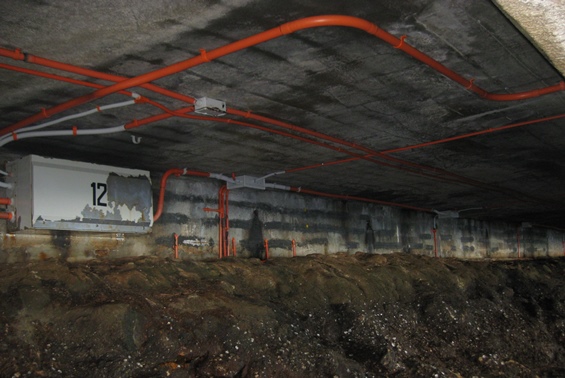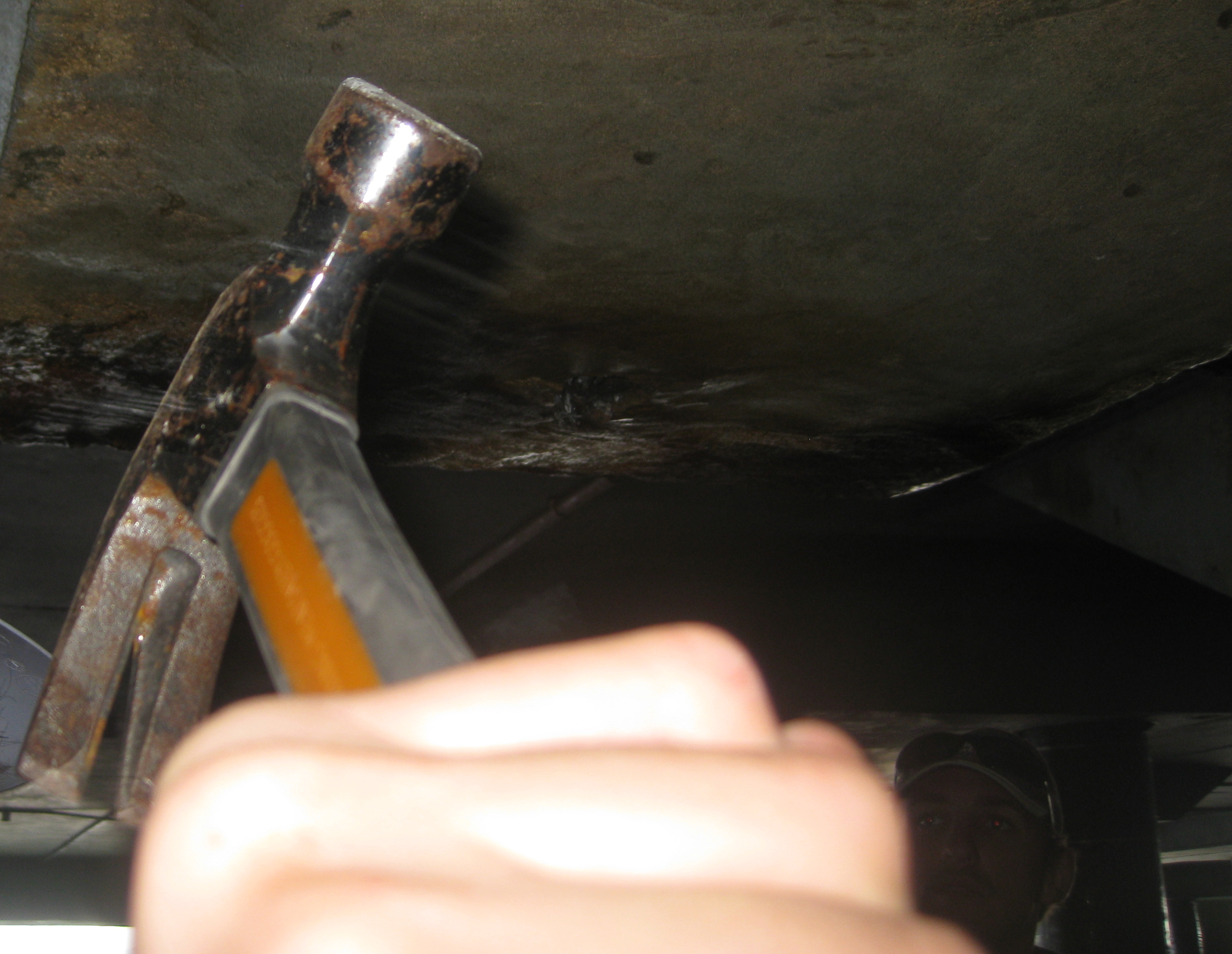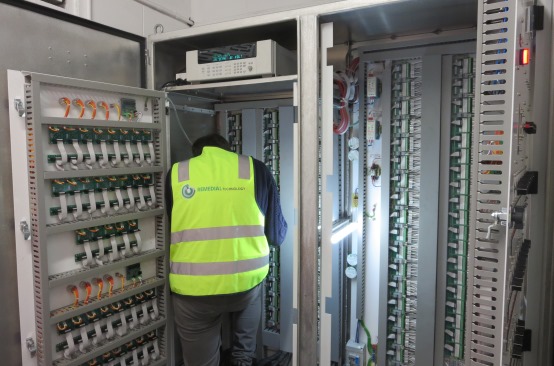The Port of Brisbane (Brisbane, Queensland, Australia), Queensland’s largest seaport, is located near the city of Brisbane at the mouth of the Brisbane River on Queensland’s southeast coast. With 29 operating berths and more than 7,700 m of quay line, this port is one of Australia’s fastest growing multi-cargo ports. Every year, the Port of Brisbane handles ~AUD$50 billion in international trade, which includes around 95% of Queensland’s containers, more than 90% of its motor vehicles, and about half of its agricultural exports.1
In 1999, an impressed current cathodic protection (ICCP) system was installed and commissioned on several steel-reinforced concrete structures that support the Port of Brisbane’s Wharves 4 and 5. Atef Cheaitani, managing director of Remedial Technology Pty., Ltd. (Gladesville, New South Wales, Australia), designed the ICCP system that was installed there more than 18 years ago. About three years ago, after the ICCP system had been in service for 15 years, the port’s management company commissioned a comprehensive audit of the Wharves 4 and 5 to assess the status of the concrete structures and ICCP system, and to determine if any renovation work was needed to sustain the ICCP system and extend the service life of the wharves for another 30 years.
The Original Cathodic Protection System
Cheaitani notes the total combined length of Wharves 4 and 5 is 600 m and the approximate area protected by the ICCP system is 8,000 m2. When the initial ICCP system was installed, he says, the area being cathodically protected—the wharves’ substructure—was in an advanced state of deterioration. Major concrete repair work was being done on the wharves’ abutment, front and rear crane beams, relieving slab, and the fenders, an area that totaled ~5,000 m2. Although chlorides had permeated the concrete to a depth beyond the steel reinforcing bar (rebar), the repair methodology included concrete removal only to the level of the rebar, which left the steel exposed to chloride-contaminated concrete. Approximately 2,000 metric tons of dry sprayed gunite were used to replace the contaminated concrete. For corrosion protection of the reinforcing steel, CP was determined to be the most effective long-term solution.
The ICCP system was divided into 13 sections; 12 sections were ~48-m long and one section was 24-m long. Each section was divided into 14 separate electrical zones that incorporated tidal areas (abutment wall and slab, relieving slab, and fender wall) and atmospheric areas (relieving slab, landward crane beam, and seaward crane beam). Issues such as variations in concrete resistivity, corroding conditions of the elements to be protected, tidal variations, and structural geometry were considered when zoning the system, Cheaitani says.
Two installation methods were used to install ~30 km of mixed metal oxide titanium ribbon anode (10-mm wide by 0.9-mm thick with a current capacity of 5.28 mA/linear meter). In the first method, 10-mm wide by 30-mm deep slots were cut into existing concrete, and the ribbon anode was placed in the slot and backfilled with grout material. Where the contaminated concrete had been removed, the second method, the ribbon anode was placed between two layers of gunite that was compatible with the existing concrete.
The ICCP system included a total of 365 embedded titanium and silver/silver chloride (Ag/AgCl) reference electrodes, with their locations determined with the results of a detailed potential and resistance mapping survey carried out during construction for every element of the structure. Additionally, 183 reference electrodes were installed in concrete as spares. For each reference electrode, a dedicated steel connection cable was installed to obtain accurate readings.

All cables from the various elements of the structure were routed to a total of 192 junction boxes with an IP67 rating (meaning fully protected from dust and can withstand submersion in 1 m of water for up to 30 min), which were located on the front crane beam and the abutment wall. All cables from the junction boxes were terminated in 13 IP67-rated control units affixed to the abutment wall every 48 m. Each control unit included a multiple number of transformer/rectifier units and components to allow potential measurement with reference electrodes, including “instant off” measurements, current adjustment, and remote communication to the main control unit. A total of 172 transformer/rectifier units (2 A/15 V) were used in the original installation. These substations were connected to the main control unit near Wharf 4 via telephone line and power supply cable. Due to space restrictions on the wharf deck, all the junction boxes and control units were installed underneath the wharves.
Cheaitani notes that the original control system was one of the most advanced control systems for CP in concrete at that time. It included remote access, a remote alarm function, graphical user interface, remote monitoring and adjustment, and many other advanced features so the system could be controlled from a distance. Based on the adopted NACE International criteria2 at that time for assessing a CP system (i.e., a 100-mV polarization development/decay criterion), the ICCP system was operating satisfactorily.
Reviewing the Cathodic Protection of the Wharves
After 15 years of system operation, following flooding from the Brisbane River that impacted the water level underneath the wharves, Cheaitani performed an audit that included an inspection of the wharf’s concrete structures and an assessment of the ICCP system components. He notes that since the original commissioning of the system, various measures had been undertaken to prevent water ingress into the control units and junction boxes from tidal action and flooding, such as periodically resealing the junction boxes and control units. Although these measures kept the ICCP system functioning, the water ingress from the harsh marine environment and high humidity could not be fully prevented. The long-term performance of the electronics was impacted and resulted in a higher rate of electronic component failure as well as increased maintenance costs.
Results of the audit indicated that the CP protection criteria at nearly all embedded reference electrodes had been achieved based on the applicable present-day Australian standard.3 Except for a very small localized ~6 m2 area where the concrete had deteriorated, the areas protected by CP were free from spalling and reinforcement corrosion. The primary cause of the localized deterioration was related to the CP system not operating in this area because of a localized short circuit between the anode and steel.
Delamination
Hammer tests were performed to check for concrete delamination. The entire concrete area—8,000 m2—was tested. Some areas (usually in the front and rear crane beams) produced a hollow sound when struck by the hammer, and were marked as potential delamination areas.
“If you don’t have concrete spalling or cracking, the only thing you can do is hammer testing to detect delamination by hearing a hollow sound. This is an indication that there is a problem in the concrete.” Cheaitani explains.

A detailed inspection at areas where delamination was suspected revealed that the gunite material encapsulating the ribbon anode was fully sufficient to pass the CP current to the embedded steel reinforcement. The suspected delamination proved not to be associated with any corrosion of the steel reinforcement.
Grout Acidification
Where the ribbon anodes were installed in slots cut in the original unrepaired concrete, there was missing grout and evidence of grout acidification at various locations in the splash and tidal zone areas. Cheaitani notes that the acidification of the grout was related to the encapsulation of the ribbon anodes in the cut slots. “The repair encapsulation wasn’t sufficient for areas subjected to tides and continuous water spray,” he comments, noting that as the tide came in and wet the areas, there was minor shrinkage cracking over time between the grout and the original concrete. As the water penetrated the material surrounding the anode, acidification occurred. “At the time of installation, this problem wasn’t really known,” he adds.
The system audit didn’t determine any evidence of a correlation between grout acidification and a reduction of anode current density, Cheaitani says. The ribbon anode was operational while immersed in water. Based on the audit results, initiation of reinforcement corrosion and concrete deterioration was not observed in the tidal and splash zones because of grout acidification, which indicated that grout acidification had no impact on the ICCP system’s performance.
Water Damage
Components with varying degrees of water damage were noted for many of the junction boxes and control units located at the abutment wall underneath the wharf. At the time of system installation, enclosures rated as IP67 were thought to be sufficient for providing protection to all components within the enclosures against moderate water exposure at high tide. However, ~50% of the control units and 50% of the junction boxes located at the abutment wall in an area with water exposure had some sort of water damage to terminals and electronics inside. The audit found, though, that 96 junction boxes located at the front crane beam and away from the water were in excellent condition.
Overall, Cheaitani says, the performance of the original ICCP system since its commissioning was very satisfactory. Locating the control units underneath the wharf, which made them susceptible to water and moisture exposure and increased the failure rate for some system components, was the main drawback of the system that needed to be addressed.
ICCP System Renovation
The scope of the renovation work was to move the junction boxes and control units to locations above the wharves while maintaining and utilizing all embedded CP system components in the concrete (ribbon anodes, reference electrodes, and cabling). While developing the configuration for this task, Cheaitani explored increasing the size of the ICCP zones and reducing the number of circuits in the existing system. This could be possible because an analysis of system data showed a similar level of current requirements between similar zones in different sections.
In theory, he explains, smaller zones in a CP design provide more control of the CP current. Doing this, however, requires more cabling, reference electrodes, and power supply units. “After analyzing more than 15 years’ worth of data, we noticed a big similarity in the level of current going to each zone within different sections, and because of this similarity we understood that small zones are not really necessary,” he says. “There is no advantage to having local zones because they all use about the same amount of current.” The guidelines he used to reduce the number of circuits was to combine zones that had similar steel density, corrosion status, and exposure conditions, as well as maintain a similar voltage drop in current delivered via the cabling.

The new design called for combining smaller circuits with the same exposure conditions and CP current requirements, merging certain zones in each section, and changing the system layout from a local distributed system, where the power supply is distributed to the individual sites of the control units, to a global supervised system, where the power is supplied to all control units in one location above the wharf.
To test the system reconfiguration, a trial application was carried out using a small number of junction boxes in Section 12, a 24-m length of the wharf. “We replaced junction boxes and did full testing of the trial area, including external mapping of potential measurements using the embedded and portable reference electrodes, to get a better understanding of the current distribution within the area,” Cheaitani says. “Basically, this verified that the new ICCP design—the combination of zoning— wouldn’t affect the system’s performance.”
Evidence gathered during the trial demonstrated the CP system performance for Section 12 was not negatively impacted when CP circuits with similar exposure and geometry were combined and the cabling was simplified. The conclusion, he comments, was that fewer large CP zones provided the same level of corrosion protection as many smaller zones.
Impressed Current Anodes vs. Sacrificial Anodes
After 15 years of system operation, the current requirement for the original ICCP to achieve corrosion protection of the wharves, based on the applicable Australian and global standards for CP, was ~11.25 mA/m2. Cheaitani comments that a sacrificial anode-based CP system would not, under any circumstances, have the capacity to deliver this level of CP current and provide the required corrosion protection of the wharves. The typical size of a galvanic zinc anode for concrete (18-mm diameter by 113-m long) will deliver between 0.4 and 0.8 mA. Even if that amount of current could be delivered continuously for a sustained period of time, it would require between 14 to 28 anodes per square meter of concrete to obtain the required level of current using sacrificial anodes, he says. This is practically impossible to achieve based on cost, practicality, and engineering considerations.
“We believe sacrificial anodes have their own applications in certain areas. For wharf structures that are always subjected to a very harsh marine environment, an impressed current system is really the only practical and cost-effective CP application to stop corrosion,” he adds.
The new system design eliminated the installation of electronics underneath the wharf, and required less cabling. The overall number of circuits was reduced from 14 to 8 in each typical section, and the number of sections was decreased from a total of 13 localized control units underneath the wharves to six control units all located in a central climate-controlled room above the wharves. This resulted in a total reduction in the number of circuits—from 172 to 48. Cable design and voltage drop calculations were performed for all cables between the structure and the new location of the controller units, and different sized cables, from 4 to 16 mm, were used between the junction boxes at the wharves and the new locations of the control units to ensure proper current delivery to all system zones.
The repair work and CP trial took about a year to complete, and the redesigned system has been performing very well since it was brought online about two years ago. “The whole idea is to build CP systems that require minimal maintenance—that is the key lesson we’ve learned over the years,” Cheaitani says. “The less maintenance you need to keep the technology viable, the more cost-effective the system is for the client. We believe future ICCP systems will have a simple design with larger zones, and use heavy-duty equipment that will not be negatively affected by the environment. If we can build a system like this, it will cost less, deliver the same CP protection, and will be extremely low maintenance, which is very important for the client.”
References
1 “Brisbane Wins Port of the Year 2017,” Port of Brisbane, News & Media, November 17, 2017, https://www.portbris.com.au/Media/News/Brisbane-wins-Port-of-the-Year-2017/ (February 13, 2018).
2 NACE RP0290-90, “Cathodic Protection of Reinforcing Steel in Atmospherically Exposed Concrete Structures” (Houston, TX: NACE International, 1990).
3 AS 2832.5-2008, “Cathodic Protection of Metals—Steel in Concrete Structures” (Sydney, Australia: Standards Australia, 2008).
Bibliography
Cheaitani, A. “Cathodic Protection to the Port of Brisbane Structure, Australia.” CORROSION 1999, paper no. 545. Houston, TX: NACE International, 1999.
Cheaitani, A. “Review of Cathodic Protection Systems for Concrete Structures in Australia.” CORROSION 2017, paper no. 9024. Houston, TX: NACE International, 2017.